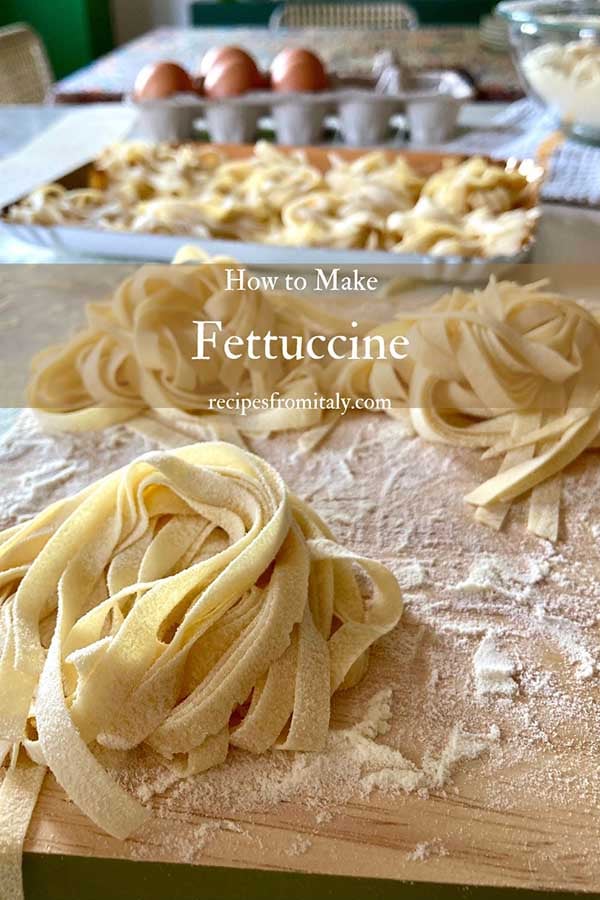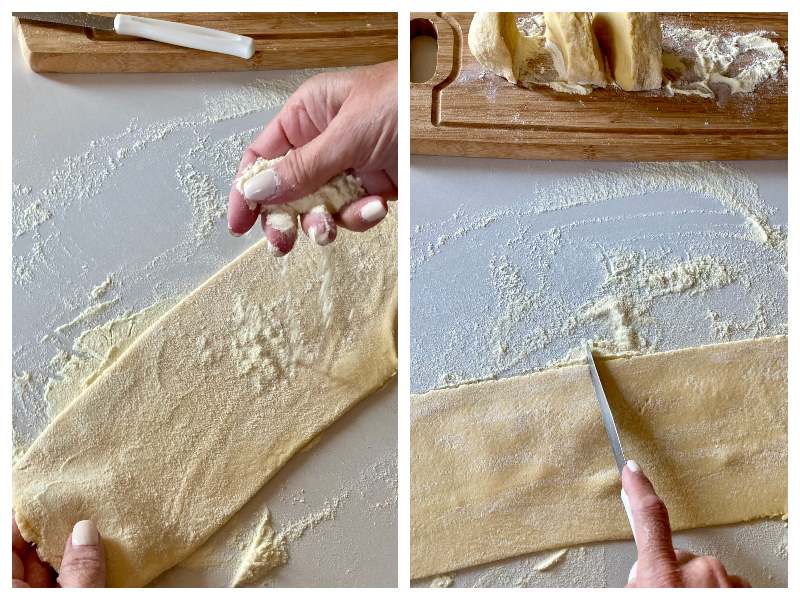Fresh fettuccine pasta is one of the most popular and traditional pasta formats in Italy. You can make fresh fettuccine pasta at home in no time and with a very simple method.
In fact, making fresh fettuccine pasta is not as difficult as it might seem. Sure, tradition dictates that you do it all by hand with arm strength and a rolling pin.

But with the help of a pasta kneading and flattening machine, everything becomes more handy and faster and the result just as good.
We made amazing egg noodles with a pasta maker machine and its handy accessories.
Now we are going to show you all the steps: from kneading the dough, to rolling out the thin sheet, to cutting the fettuccine. Finally how to store and cook them.

We opted for a dough prepared with two types of flours, soft wheat flour and remilled durum wheat semolina flour in equal amounts and, of course, very fresh eggs.
The result is firm fettuccine that holds up well when cooked.
Cooking is fairly quick; in about 2 minutes the fettuccine noodles will be cooked. Season with the toppings you like best.
Follow our step-by-step recipe and see how easy it's to make homemade fresh fettuccine pasta from scratch!
Enjoy homemade fettuccine with Ragù Bianco (White Bolognese Sauce)

Ingredients
- Prep Time: 1 H
- Servings: 6
- 200 g (1 ½ cup) of "00" Soft Wheat Flour
- 200 g (1 ½ cup) of remilled durum wheat flour (semola flour)
- 4 eggs of at least 70 g (2,5 oz) each. Fresh homemade pasta usually wants 1 egg x 100 g (¾ cup) of flour
Kitchen Tools and Equipment
To make fresh homemade noodles, we used the KitchenAid stand mixer with the pasta maker attachment for KitchenAid. 3-in-1 set that includes dough sheet roller, tagliolini cutter and fettuccine cutter.
Instructions
The Pasta Dough
To prepare fresh fettuccine pasta with KitchenAid (or any other pasta making machine) proceed as follows:

Step 1) - First, sift the two flours. Then pour the two sifted flours into the steel bowl of your stand mixer and add the eggs.

Step 2) - Using the flat "leaf" whisk, set speed 2 on the mixer and mix the ingredients for half a minute.

Step 3) - At this point, remove the flat "leaf" whisk and insert the kneading "hook" and, still at speed 2, knead for 2 to 3 minutes, until it forms a single firm dough ball.
PLEASE NOTE: if after about 2 minutes the dough does not clump together but remains crumbly, add one or two tablespoons of water.

Step 4) - Now sprinkle the work surface with semolina flour, remove the dough from the bowl, and knead by hand for 2 minutes.
Form a ball with the dough, wrap it with plastic wrap or in a tea towel and let it rest for about 20 minutes.

Step 5) - Now attach the sheeter to the KitchenAid and proceed with the dough sheet.
Take the dough and divide it into portions of about 100 g (3,5 oz). Next, take a piece of dough and flatten it with your hands.
Be careful to keep the remaining pieces of dough covered to prevent them from drying out.

Step 6) - Set the knob of the sheeter to level 1 and speed 2. Put the dough in the rollers and pass it the first time.
Make the Folds

Step 7) - Now you need to make the folds. So, fold the dough in half, and then in half again.

Step 8) - Flour with semolina and pass it through the rollers again.
Repeat 2 or 3 times (fold/pass - fold/pass), until the dough becomes smooth and elastic.

Step 9) - Remember to flour the pasta sheet with semolina flour whenever you feel it's sticky. If the sheet of dough becomes too long, cut it in half.

Step 10) - Now turn the knob of the sheeter to level 2, again at speed 2, and repeat the steps, to further roll out the dough.
DO NOT make any more folds and start thinning the dough by running it through the smooth roller at least a couple of times.
From position 2 move to position 3 and repeat.
According to our taste, the thickness of the dough is just right for fettuccine in position 3. Not too thin and not too thick. If you want thinner fettuccine, move to position 4 and proceed as instructed.
Make the Fettuccine

Step 11) - Now move on to the preparation of the fettuccine noodles. Remove the sheeter from the KitcheAid and connect the fettuccine tool.
Also flour a tray with semolina flour that can comfortably hold your fresh fettuccine pasta.

Step 12) - At speed 1, insert the well-floured sheet of pasta between the blades of the fettuccine tool. With the other hand, accompany and finally gently pull out the fettuccine noodles.

Step 13) - Gather the fettuccine pasta with your hands and place them on the floured tray.
Divide the fettuccine into portions of about 50 g (1,7 oz), rolling them with your hand to form pasta nests.

YOU MUST ALSO TRY:
- How to Make Homemade Trofie Pasta
- Pumpkin Ravioli with Sage Butter
- How to Make Homemade Passatelli
- traditional italian polenta recipe
- How to Make Homemade Orecchiette
- Homemade Farfalle (Italian Bow Tie Pasta)
- Spaghetti alla Chitarra (Tonnarelli) Recipe
Storage
If you plan to cook the fettuccine later in the day, simply cover them with a cotton cloth and let them rest.
Hence you can make them in the morning for lunch, for example, and store them covered at room temperature. On the other hand, if you make them in the morning for dinner, store them covered in the refrigerator.
Is it Possible to Freeze Fresh Homemade Fettuccine?
The good news is that it doesn't matter when you make them! Because freezing is the safest, most practical and fastest way to store fresh homemade fettuccine. Here's how to do it:

Arrange the nests of fettuccine on previously floured trays. Cover with plastic wrap or foil. Finally place the pasta nests in the freezer, in a horizontal position.
Once completely frozen, remove them from the tray and store them inside food-grade bags. They take up less space this way. Place back in the freezer.
Fresh homemade fettuccine will keep in the freezer for up to 6 months.

Tips
How to Cook Fettuccine
Fresh egg fettuccine, like all homemade pasta in general, usually have a short cooking time. It depends, of course, on the thickness of the fettuccine.
Preparing a good pasta dish always starts with water: the rule is that for 1 liter (4 cups) of water, you need 100 g (3.5 oz) of pasta and 10 g (½ tablespoon) of coarse salt.
The proportion of water to pasta is critical. This ensures that the starch can dissolve in the right amount of water without forming a saturated solution.
This would make the pasta sticky and undigestible.

When the water boils, add the salt and dip the fettuccine. Add a tablespoon of oil to prevent sticking and stir. Cook for 2 to 3 minutes. Taste to make sure they are cooked.
Drain with a slotted pasta ladle, and place your fettuccine directly into the bowl with the sauce of your choice.
What is the Difference Between Fettuccine and Tagliatelle?
You maybe are thinking it's incredible, but there is absolutely no difference between fettuccine and tagliatelle, except for the width!
In fact, traditionally fettuccine have a maximum width of 5mm (about ¼ inch) while tagliatelle are slightly wider, 10 mm (about ½ inch).
Therefore fettuccine and tagliatelle are identical in terms of preparation, cooking and conservation.
Simply, in the north of Italy they are called tagliatelle for the way they are prepared, that is they are “tagliate” (cutted). In the south of Italy, and in particular in Rome, they are called fettuccine, from "fetta" (slice).
The name "Fettuccine" is more used abroad (as for the famous Fettuccine Alfredo) because many Italian immigrants to the Americas came from Southern Italy, where they used this name for this amazing pasta.

Why There is NO Salt in the Dough?
In Romagna making fresh egg pasta at home is an institution. They don't put salt in the dough because (rightly) the pasta is cooked already in salted water.
Therefore, even the fettuccine, as they cook, absorb salt water and get just the right amount of flavor.
That's why it's not necessary to add salt to the dough, so as not to make fresh pasta dishes that are too salty!

Recipe Card

Fresh Fettuccine Pasta Recipe
Ingredients
- 200 g "00" Flour 1 ½ cup, “00” Soft Wheat flour
- 200 g Semolina 1 ½ cup, remilled durum wheat flour
- 4 eggs of at least 70 g (2.5 oz each). Fresh homemade pasta usually wants 1 egg x 100 g (¾ cup) of flour
Instructions
Make the Dough
- Pour the two sifted flours into the steel bowl of your stand mixer and add the eggs. Using the flat "leaf" whisk, set speed 2 on the mixer and mix the ingredients for half a minute.
- At this point, remove the flat "leaf" whisk and insert the kneading "hook" and, still at speed 2, knead for 2 to 3 minutes, until it forms a single firm dough ball.
- Sprinkle the work surface with semolina flour, remove the dough from the bowl, and knead by hand for 2 minutes.
- Form a ball with the dough, wrap it with plastic wrap or in a tea towel and let it rest for about 20 minutes.
- Attach the sheeter to the KitchenAid and proceed with the dough sheet. Take the dough and divide it into portions of about 100 g (3,5 oz). Next, take a piece of dough and flatten it with your hands. Be careful to keep the remaining pieces of dough covered to prevent them from drying out.
- Set the knob of the sheeter to level 1 and speed 2. Put the dough in the rollers and pass it the first time.
Make the Folds
- Fold the dough in half, and then in half again.
- Flour with semolina and pass it through the rollers again.
- Repeat 2 or 3 times (fold/pass - fold/pass), until the dough becomes smooth and elastic.
- Remember to flour the pasta sheet with semolina flour whenever you feel it's sticky. If the sheet of dough becomes too long, cut it in half.
- Now turn the knob of the sheeter to level 2, again at speed 2, and repeat the steps, to further roll out the dough. DO NOT make any more folds and start thinning the dough by running it through the smooth roller at least a couple of times.
- From position 2 move to position 3 and repeat.
- According to our taste, the thickness of the dough is just right for fettuccine in position 3. Not too thin and not too thick. If you want thinner fettuccine, move to position 4 and proceed as instructed.
Make the Fettuccine
- Move on to the preparation of the fettuccine. Remove the sheeter from the KitcheAid and connect the fettuccine tool. Also flour a tray with semolina flour that can comfortably hold your fresh fettuccine pasta.
- At speed 1, insert the well-floured sheet of pasta between the blades of the fettuccine tool. With the other hand, accompany and finally gently pull out the fettuccine noodles.
- Gather the fettuccine pasta with your hands and place them on the floured tray. Divide the fettuccine into portions of about 50 g (1,7 oz), rolling them with your hand to form pasta nests.





Cathy says
This is a great recipe with very clear and easy to follow instructions. Thank you for sharing it.
Karen Wagoner says
is there a cream sauce to go with this recipe?